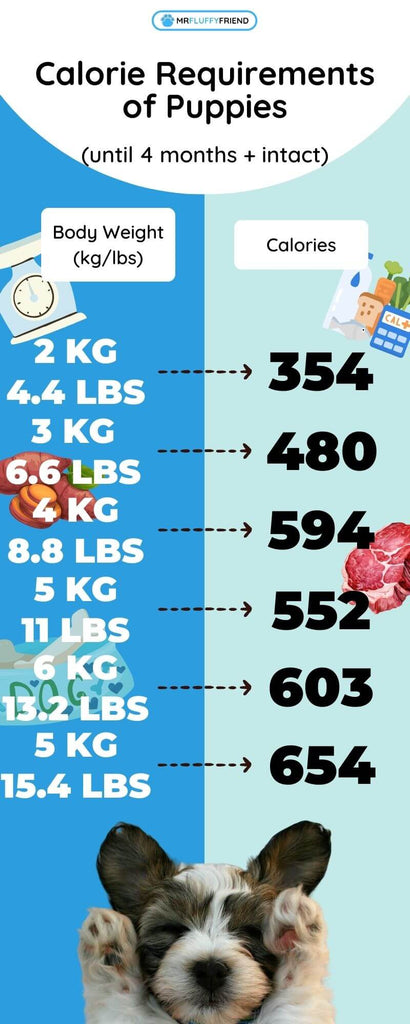How Much Raw Food Should Puppies Eat?
Welcome to the second part of our BARF series!
We understand that feeding your puppy a raw food diet can be a controversial topic among pet owners.
Passionate advocates sing praises about its benefits while sceptics expressing concerns.
As a responsible pet owner, you want to ensure your Fluffy Friend receives the best nutrition for optimal health and growth.
In this post, we'll explore the following (click the links below to go to that section):
- Factors that affect a puppy's diet
- How much raw food should puppies consume?
- What should you look out for?

What Factors Affect a Puppy’s Diet?

- Weight
One of the primary factors influencing a puppy's dietary needs is their weight.
Puppies, like humans, come in various shapes and sizes.
As we’ve mentioned before, there’s no one-size-fits-all approach to feeding raw.
Larger breeds, for instance, may require a different feeding strategy than their smaller counterparts to support their rapid growth and development.
- Energy/Activity Level
A puppy's energy and activity levels are key considerations when determining their diet.
Active dogs burn more calories and may need a higher intake of energy-rich foods to sustain their lifestyle.
You need to understand your puppy's play time and exercise routine so you can carefully tailor their diet to meet their specific needs.
- Breed
Different breeds have distinct nutritional requirements.
Large breed puppies, for example, may be prone to orthopaedic issues.
This means that it’s necessary to find a careful balance of nutrients to support bone and joint health.
Smaller breeds may have different metabolic rates.
To accommodate this, adjust the portion sizes to prevent overfeeding.
- Spayed/Neutered
The decision to spay or neuter your puppy can impact their dietary needs.
Altered dogs often have different metabolism rates and may require caloric adjustments.
Make sure to monitor their weight and adjust the diet accordingly.
This is a precautionary measure that can prevent obesity-related health issues.
Why Is Appropriate Feeding Important?
Ensuring your puppy receives the right amount of nutrition is vital for their overall health and wellbeing.
A well-balanced diet contributes to:
- Muscle Development
Protein is vital for building and maintaining muscle mass.
Raw diets, consisting of muscle meat, organ meats, and raw meaty bones, provide a natural and biologically appropriate source of protein for your growing puppy.
Adequate protein intake supports proper muscle development.
It also helps them reach their ideal weight.
- Immune System Support
A balanced raw diet is rich in essential nutrients that contribute to a robust immune system.
Proper nutrition ensures your puppy's body can fight off infections and diseases.
- Digestive Health
The raw food diet is often praised for its positive effects on the digestive tract.
Raw feeders argue that it mimics the natural diet of canines.
Also, they mention that a raw diet leads to better digestion and absorption of nutrients.
Still, you must monitor your puppy's adjustment to prevent loose stools or digestive upset.
- Healthy Weight Maintenance
Maintaining an ideal body weight is vital for a puppy's overall health.
Raw diets, when properly portioned, can help prevent obesity-related health problems.
Observe your puppy's body condition, then adjust accordingly.
Related: Eggcellent Easter Basket Ideas for Pets
How Much Raw Food Should Puppies Eat?

Determining the right amount of raw food for your puppy involves careful consideration of various factors.
Here are a few general guidelines to help you start:
- General Guideline
A common rule of thumb is to feed puppies 2-3% of their current weight.
However, this percentage can vary based on factors explained above.
This guideline only provides you a starting point for adjusting the amount of food based on your puppy's individual needs.
- Life Stages
Puppies go through different life stages, each with its own nutritional requirements.
Young puppies, especially those under six months of age, may need more frequent, smaller meals to support their rapid growth.
As they transition to adolescence and adulthood, feeding frequency and portion sizes can be adjusted accordingly.
- Active Dogs
If your puppy is particularly active or engaged in regular exercise, they may require a higher percentage of their body weight in food.
Active dogs burn more calories and need additional energy to support their lifestyle.
Monitoring their weight and adjusting the food intake so that they can still receive the necessary nutrients without excess calories.
- Larger Breeds
Large breed puppies, such as Great Danes or Mastiffs, have unique nutritional needs.
Rapid growth in these breeds can lead to orthopaedic issues, making it crucial to monitor their diet closely.
Some raw feeders recommend slightly lower percentages (around 2-2.5%) for large breed puppies to support more controlled growth.
- Smaller Dogs
Conversely, smaller breeds may have faster metabolisms.
They require a slightly higher percentage of their body weight in food.
Adjusting portion sizes based on your puppy's size and breed ensures they receive the appropriate amount of nutrients for their specific needs.
- Starting Point
Using a raw feeding calculator can be helpful for pet owners new to the concept of raw feeding.
These calculators take into account your puppy's weight, age, and activity level.
In this way, the calculator can provide an estimate of your dog’s daily food intake.
The Best Way to Feed Raw

The best way to introduce your puppy to a raw food diet is to start with a balanced approach.
A balanced raw diet includes:
- Muscle Meat
Muscle meat should form the foundation of your puppy's raw diet.
This includes a variety of meats like beef, chicken, turkey, and lamb.
Provide a mix to ensure a diverse range of nutrients and proteins for overall health.
- Organ Meats
Organ meats, such as liver and kidney, are rich in essential vitamins and minerals.
They contribute to a well-rounded diet that helps provide key nutrients lacking in muscle meat alone.
- Raw Meaty Bones
Raw meaty bones are important to the BARF diet.
It offers dental benefits and is a natural source of calcium.
Other options include chicken wings, turkey necks, and other bones appropriate for your puppy's size and breed.
Disclaimer:
Bones are a choking hazard.
Make sure that your puppy has easy access to clean water at all times.
- Essential Fatty Acids
Incorporating essential fatty acids into your puppy's diet is necessary.
Sources like fish oil or certain cuts of fatty fish provide omega-3 fatty acids, contributing to a shinier coat and supporting cognitive function.
Related: BARF 101: Biologically Appropriate Raw Foods
Common Pitfalls and How to Avoid Them

While raw feeding can offer numerous benefits, there are common pitfalls that pet owners should be aware of:
1. Overfeeding
Feeding too much food, even if it's raw and nutritionally dense, can lead to obesity.
Also, overfeeding can lead to other health problems.
Pay close attention to your pup's weight and adjust their diet accordingly to prevent overfeeding.
Never forget to wash your puppy’s food bowl after every meal.
Refrigerate leftovers as soon as your puppy is done eating or throw them away safely.
2. Digestive Upset
Switching to a raw diet abruptly can cause digestive upset.
Your pup may experience diarrhoea or vomiting.
Make sure to gradually transition your puppy to raw food for over a week or two.
This can allow their digestive system to adjust and minimise potential issues.
3. Lack of Essential Nutrients
Ensure your puppy's diet is well-balanced to prevent deficiencies.
Ask for help from a pet nutritionist or veterinarian in creating a balanced raw diet that meets all your puppy's nutritional needs.
4. New Proteins
Introduce new proteins gradually to monitor your puppy's reactions.
Some pups may be sensitive to some proteins.
Thus, a slow introduction helps identify any potential allergies or sensitivities.
Related: Dog Feeding 101: Choose the Right Food for Your Dog

Conclusion
Determining how much raw food puppies should eat involves many things.
Various factors such as weight, energy levels, breed, and spaying/neutering status are crucial.
While general guidelines are available, you need to adapt your puppy's diet based on their unique needs and life stage.
As we like to say, every puppy is different.
Thus, finding the right balance may require some experimentation.
If you have concerns or questions about your puppy's diet, consult a veterinarian or a pet nutritionist.
They can provide personalised guidance and ensure your Fluffy Friend thrives on their raw food journey.
Embracing a raw diet can be a rewarding and fulfilling choice for pet owners dedicated to the health and wellbeing of their canine companions.
Stay tuned for part three of our BARF series!
Looking for some products that could help you out?
Check out our Online Shop!
Here are some useful products in relation to this blog post:
MrFluffyFriend - Orthopaedic Pillow
